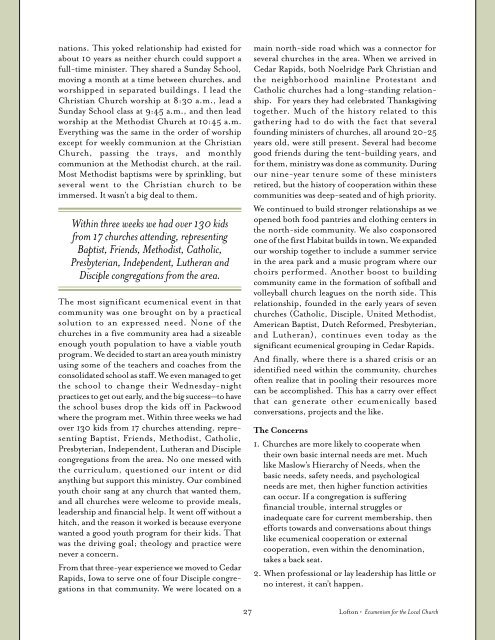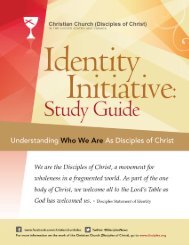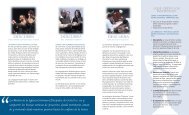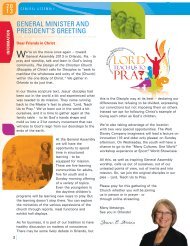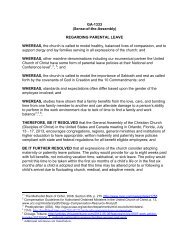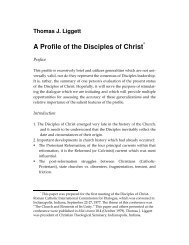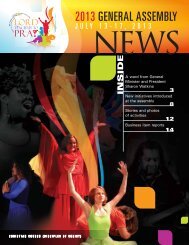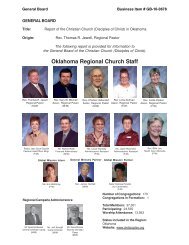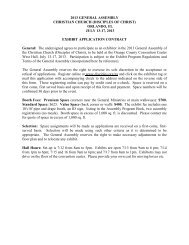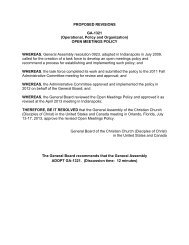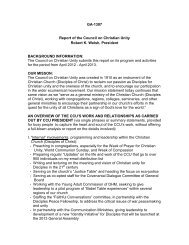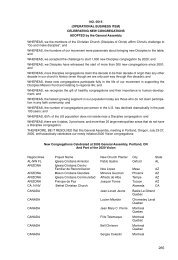RESOURCING THE CHURCH FOR ECUMENICAL MINISTRy A ...
RESOURCING THE CHURCH FOR ECUMENICAL MINISTRy A ...
RESOURCING THE CHURCH FOR ECUMENICAL MINISTRy A ...
Create successful ePaper yourself
Turn your PDF publications into a flip-book with our unique Google optimized e-Paper software.
nations. This yoked relationship had existed for<br />
about 10 years as neither church could support a<br />
full-time minister. They shared a Sunday School,<br />
moving a month at a time between churches, and<br />
worshipped in separated buildings. I lead the<br />
Christian Church worship at 8:30 a.m., lead a<br />
Sunday School class at 9:45 a.m., and then lead<br />
worship at the Methodist Church at 10:45 a.m.<br />
Everything was the same in the order of worship<br />
except for weekly communion at the Christian<br />
Church, passing the trays, and monthly<br />
communion at the Methodist church, at the rail.<br />
Most Methodist baptisms were by sprinkling, but<br />
several went to the Christian church to be<br />
immersed. It wasn’t a big deal to them.<br />
Within three weeks we had over 130 kids<br />
from 17 churches attending, representing<br />
Baptist, Friends, Methodist, Catholic,<br />
Presbyterian, Independent, Lutheran and<br />
Disciple congregations from the area.<br />
The most significant ecumenical event in that<br />
community was one brought on by a practical<br />
solution to an expressed need. None of the<br />
churches in a five community area had a sizeable<br />
enough youth population to have a viable youth<br />
program. We decided to start an area youth ministry<br />
using some of the teachers and coaches from the<br />
consolidated school as staff. We even managed to get<br />
the school to change their Wednesday-night<br />
practices to get out early, and the big success—to have<br />
the school buses drop the kids off in Packwood<br />
where the program met. Within three weeks we had<br />
over 130 kids from 17 churches attending, representing<br />
Baptist, Friends, Methodist, Catholic,<br />
Presbyterian, Independent, Lutheran and Disciple<br />
congregations from the area. No one messed with<br />
the curriculum, questioned our intent or did<br />
anything but support this ministry. Our combined<br />
youth choir sang at any church that wanted them,<br />
and all churches were welcome to provide meals,<br />
leadership and financial help. It went off without a<br />
hitch, and the reason it worked is because everyone<br />
wanted a good youth program for their kids. That<br />
was the driving goal; theology and practice were<br />
never a concern.<br />
From that three-year experience we moved to Cedar<br />
Rapids, Iowa to serve one of four Disciple congregations<br />
in that community. We were located on a<br />
27<br />
main north-side road which was a connector for<br />
several churches in the area. When we arrived in<br />
Cedar Rapids, both Noelridge Park Christian and<br />
the neighborhood mainline Protestant and<br />
Catholic churches had a long-standing relationship.<br />
For years they had celebrated Thanksgiving<br />
together. Much of the history related to this<br />
gathering had to do with the fact that several<br />
founding ministers of churches, all around 20-25<br />
years old, were still present. Several had become<br />
good friends during the tent-building years, and<br />
for them, ministry was done as community. During<br />
our nine-year tenure some of these ministers<br />
retired, but the history of cooperation within these<br />
communities was deep-seated and of high priority.<br />
We continued to build stronger relationships as we<br />
opened both food pantries and clothing centers in<br />
the north-side community. We also cosponsored<br />
one of the first Habitat builds in town. We expanded<br />
our worship together to include a summer service<br />
in the area park and a music program where our<br />
choirs performed. Another boost to building<br />
community came in the formation of softball and<br />
volleyball church leagues on the north side. This<br />
relationship, founded in the early years of seven<br />
churches (Catholic, Disciple, United Methodist,<br />
American Baptist, Dutch Reformed, Presbyterian,<br />
and Lutheran), continues even today as the<br />
significant ecumenical grouping in Cedar Rapids.<br />
And finally, where there is a shared crisis or an<br />
identified need within the community, churches<br />
often realize that in pooling their resources more<br />
can be accomplished. This has a carry over effect<br />
that can generate other ecumenically based<br />
conversations, projects and the like.<br />
The Concerns<br />
1. Churches are more likely to cooperate when<br />
their own basic internal needs are met. Much<br />
like Maslow’s Hierarchy of Needs, when the<br />
basic needs, safety needs, and psychological<br />
needs are met, then higher function activities<br />
can occur. If a congregation is suffering<br />
financial trouble, internal struggles or<br />
inadequate care for current membership, then<br />
efforts towards and conversations about things<br />
like ecumenical cooperation or external<br />
cooperation, even within the denomination,<br />
takes a back seat.<br />
2. When professional or lay leadership has little or<br />
no interest, it can’t happen.<br />
Lofton • Ecumenism for the Local Church


